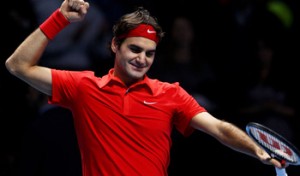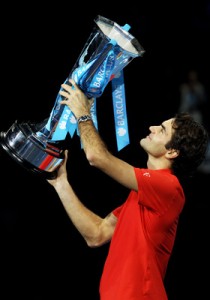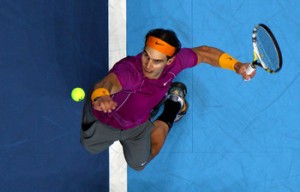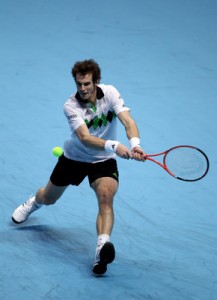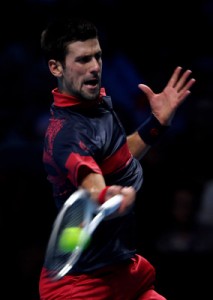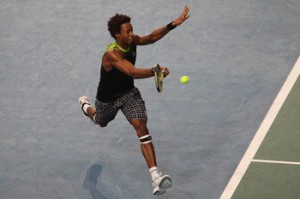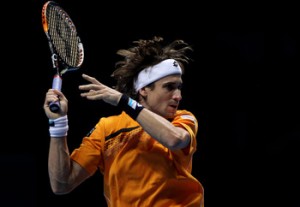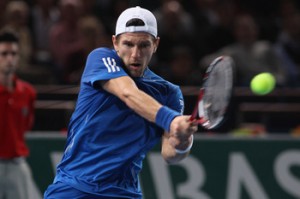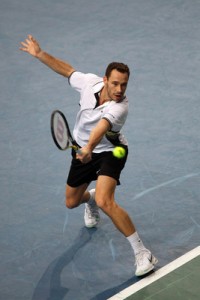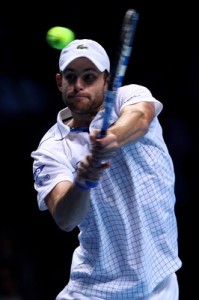Final 2010 ATP Power Ranking: Roger Federer Rules
The World Tour Finals in London brought the climax to the tennis season that most fans dreamed of.
And as a result, there will be only one story in the tennis headlines for the rest of 2010.
With apologies to the Serbian and French men now summoning up their final reserves of energy for the Davis Cup final, it looks set to be the Roger-and-Rafa show from now until the next Grand Slam in Australia.
One or other of them has topped the tennis rankings for the last seven years and, despite the occasional flurry of excitement as Novak Djokovic overtook a Federer finding his way back from illness in early summer and the musical chairs between Djokovic, Andy Murray and Robin Soderling in the closing months of the year, Roger and Rafa have opened clear water of more than 3,000 points between themselves and the following three.
Nadal—riding high on his best ever season—can now begin to see the super-Swiss in his rear-view mirror, despite remaining over 3,000 clear. Only right, then, that they should fight it out at the bitter end in a bitter London.
But below them, only 455 points separate Nos. 3, 4 and 5, and barely a 1,000 separates the rest of the top 10. These bare statistics, though, cannot disguise the drama that has surrounded the top two protagonists in the last 12 months.
Just a year ago, Nadal had the worst possible end to 2009 with three Round Robin losses at the World Tour Finals. Last week in London, he won all three, then a pulsating semi against Murray and went the distance in a show-stopping final against Federer.
In the interim, Nadal had won the “Clay Slam,” three out of four Grand Slams, claimed a “career Slam” and opened up a mammoth lead of 4,500 points in the rankings.
Meanwhile, Federer’s year slid from the heights of Grand Slam victory in Melbourne, via a lung infection in the spring, to early exits in three Masters on the bounce to players who had never beaten him before—squandering match points along the way.
He then brought an abrupt end to his record of 23 consecutive Grand Slam semis at Roland Garros. And his fall in the quarterfinals of Wimbledon was the first time he failed to reach the final since 2002.
In July, Federer dropped to No. 3 for the first time since November 2003. Within a month, though, he was back to No. 2 and on the up escalator, finishing the year with a glut of titles and points.
So the Roger-and-Rafa drama was destined to go all the way to the 2010 finishing line, as these two charismatic and charming champions first shared the major ATP end-of-year trophies and then fought for the WTF title in their 22nd match, their 18th final, but only their fourth contest in almost two years.
It was the match between the winners of 21 of the last 23 Grand Slams tournaments. And while the head-to-head odds were in the Spaniard’s favour—14-7—the Swiss had won both their previous indoor encounters, both of them at the year-end tournament.
It turned out to be a nail-biter that swung first Federer’s way, then Nadal’s, then back to the Swiss playing some of his finest tennis of the year. The win has determined the final placing of the 2010 Power Rankings and provides the perfect launch pad to the 2011 season for one of the greatest sporting rivalries of our age.
This final appraisal of the year also provides an opportunity for a review of the high-spots of the crème-de-la-crème: the eight World Tour Finalists.
1. Roger Federer, Last Power Ranking: 2; ATP Ranking: 2
Last Four Tournaments: World Tour Finals (Winner), Paris (Semifinals), Basel (Winner), Stockholm (Winner)
Power Ranking Points: 1,787
With illness and a poor spring season behind him, Federer hit the courts with a vengeance after Wimbledon, enjoying renewed fitness, a new coach and, it would seem, unalloyed desire to turn his year around.
He came into London with four titles from eight finals, but look at that latter half of 2010.
Since his quarterfinal loss at the All England Club, he won 29 of 33 matches during seven tournaments, reaching five finals. He went from the Toronto Masters final to the Cincinnati Masters title—his 90th tour-level final and one Masters title short of Nadal’s record 18.
After a semifinal fall in the U.S. Open, he reached the final of the Shanghai Masters and won his 64th and 65th titles back-to-back in Stockholm and Basel before a semi exit in Paris.
He put together a match-packed, hard-court six weeks that began in Shanghai and concluded with an unbeaten run in London—that’s 23 matches in six weeks—and looked as fast and fluid in beating both Djokovic and Nadal in the last event as he had in his opening wins over Djokovic and Robin Soderling in China.
Hard work, the wily eye of Paul Annacone, a determination to return to old-fashioned attacking tennis and a missile of a back-hand top-spin drive brought their reward and make him the man to beat, once again, at the Australian Open.
Before then, he is taking a week’s holiday, playing a couple of much publicised exhos against Nadal for their respective charities, and then it’s the tour again almost before the clock ticks across to 2011.
Perhaps that’s what he has needed. Matches, court-time, and the intensive training stretches that can only come from his longest unbroken period without injury or illness in more than two years. If it continues, his declared aspiration for that No. 1 ranking begins to look a very good bet indeed.
2. Rafael Nadal, Last Power Ranking: 8; ATP Ranking: 1
Last Four Tournaments: World Tour Finals (Finals), Shanghai (R16), Tokyo (Winner), Bangkok (Semifinals)
Power Ranking Points: 1,085
Nadal’s WTF pool was full of intrigue, particularly surrounding the Spaniard himself.
He had, just weeks before, withdrawn from Paris with shoulder tendonitis.
So although he was more rested than any of the men in London, his fitness was uncertain. However, everyone hoped for a contrasting performance from his weary 2009 exit with three Round Robin losses.
As Nadal launched into his confrontation against No.8 Andy Roddick, it looked at first like a 2009 replay. Roddick broke immediately, out-baselining Nadal at his own game.
It took the Spaniard a good set and a half to adjust to the slow conditions while Roddick thrived. Down a set and a break, however, Nadal started to motor, found his length and began to punish any net attack from Roddick with devastating cross-court passes. Nadal broke early in the third to take what became an inevitable win.
His match against Djokovic was also a close affair—until 5-5 in the first set—but Nadal ran out a convincing straight sets winner, as he did against Tomas Berdych.
The more he played, the better his tennis became, finding his base-line nicking best in an intense three-setter against Murray. But against Federer in his pomp, Nadal found the challenge of one more three-setter a step too far, but it marked his best year-end result of his best-ever season.
For Nadal ended 2010 head and shoulders above the rest in the rankings, with seven titles from nine finals—three of the wins in Slams—and a 71-10 win-loss ratio.
He became the youngest man in the Open era to win a career Slam, the first ever to win the “Clay Slam” and overtook Agassi’s record of Masters titles with his 18th in Madrid. He dropped no sets at Roland Garros and only one at Flushing Meadows. He ends 2010 in better shape than he’s ended any season in years, and has a better all-round game and serve to go with it.
He has huge points to defend in 2011, falling short of the quarters only once in the whole of 2010, and that will be the main hope for the chasing pack as it pursues the most demanding opponent in the tennis.
3. Andy Murray, Last Power Ranking: 4; ATP Ranking: 4
Last Four Tournaments: World Tour Finals (Semifinals), Paris (Quarterfinals) Valencia (R16) Shanghai (Winner)
Power Ranking Points: 614
The opening match of the WTF 2010 could not have been a better one for British fans, as Andy Murray aimed to become their hero in London.
Dressed in black, but with an unusual brightness in his eyes, he took to court against the most recent Masters champion of the year, Robin Soderling. Just the week before, the Swede pushed the Scot to fifth place in the rankings. By the close of the WTFs, their places would be reversed again.
It was quickly clear that Murray was on a mission, and Soderling was caught on the back foot. Twice in the first set, Murray broke, diminishing the Soderling attack with drops and cross-court drives that knifed past the net-approach of the Swede.
The second set was closer but never looked like reversing the outcome. Murray, in a rare show of joy, leapt into air to celebrate the win.
He followed it with a more lacklustre showing against Federer, however, before pummelling David Ferrer to the bottom of the pool. But he saved his best for last in possibly the match of the tournament against Nadal in the semis.
Taking more than three hours, two tie-breaks and three sets to separate them, Murray showed all the attacking spirit and resilience that the British had hoped for and a generosity in defeat that the British love.
The Murray cause was also helped in 2010 by his becoming, in Melbourne, the first Briton in 72 years to reach the finals of two Slams. His loss to Federer in Australia hit his confidence, however, and he endured some poor results through the spring, with back-to-back opening round exits at Miami and Monte Carlo. He the won just one match at the next Masters in Rome.
Murray made up for lost time on the autumn hard courts by beating Federer in both the Toronto and Shanghai Masters finals, and won the latter for the loss of just 25 games in five matches.
Murray is expected to announce his choice of new coach at the start of the next season. He is also scheduled to play the Hopman Cup again. That brought a smile both to his face and the face of the British public last year.
His target, though, will be to go one better in Melbourne. A truly confident Murray might just do so.
4. Novak Djokovic, Last Power Ranking: 6; ATP Ranking: 3
Last Four Tournaments: World Tour Finals (Semifinals), Paris (R16), Basel (Finals), Shanghai (Semifinals)
Power Ranking Points: 556
Djokovic’s opening match in London was a repeat of his semi-final against Berdych at Wimbledon this year.
Since losing that match, however, Djokovic had compiled a 26-6 record on the tour against a floundering Berdych with 8-12, and the Serb hit the ground running at the O2.
Indeed he looked as though he was in a big hurry to the weekend, playing near flawless tennis, right up to the ninth game against Nadal in his second round match.
Djokovic had gone out at the Round Robin stage last year despite winning two of his three matches, and had to beat Nadal to guarantee a semifinal place this year. Thus, his frustration at losing after having on-court problems with his contact lenses was easy to understand.
The errors began to leak from Djokovic—20 of his 31 tally were struck in the second set—and Nadal raced to a win.
Ever the entertainer, Djokovic walked into his final Round Robin match sporting an eye patch, but quickly showed Andy Roddick that there was nothing wrong with his sight this time, and he advanced to a highly-anticipated show-down with Federer in the semis.
What he couldn’t have predicted—nor done much about—was the form that the Swiss brought to their match.
Djokovic put it quite simply: “I didn’t have a chance.”
He does, though, have a chance for more titles—and the Australian Open might be his best prospect—in 2011. He ended this year just a whisker behind Federer and Roddick in win rates on hard courts. He reached the quarterfinals or better in all four 2010 Slams for the first time and the final of the U.S. Open. He reached No. 2 for the first time in his career, and he won two titles from four finals.
This year has seen a maturing both of the character and the tennis of the Serb, and if he leads his country to Davis Cup victory this week, he will be brimming with confidence, too.
He just needs to keep an eye on all those contact lenses.
5. Robin Soderling, Last Power Ranking: 1; ATP Ranking: 5
Last Four Tournaments: World Tour Finals (RR 1 win, 2 losses) Paris (Winner), Valencia (Semifinals), Stockholm (Quarterfinals)
Power Ranking Points: 453
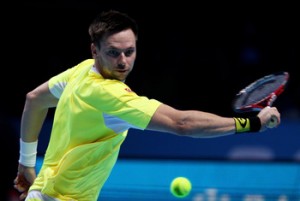
Sweden's Soderling briefly held the No. 4 ranking but fell back to No. 5 after the tournament in London.
After reaching the semis in 2009, and riding high on his first Masters title just the week before in Paris, much was expected of the Swede, but Murray left him floundering in his first match while Federer filleted him like a fish in his third.
In between, a sluggish Soderling battered his way to a win over Ferrer with a vastly improved serve percentage—70 compared with 57 against Murray.
Despite his Round Robin exit, though, Soderling has had another year of progress under the intelligent and calming eye of Magnus Norman. He has worked on his mobility, attacks the net more readily and is quicker around the court. He has also developed much greater focus and control.
He has been rewarded with two titles and three other finals this year, including his second Roland Garros final in a row. And his Paris Masters win took him to a career high of No. 4, albeit for just a couple of weeks.
All the more surprising, then, that Soderling has just this week announced a split from Norman, who says he wishes to focus more on his personal life. Soderling will shortly announce Norman’s replacement, but make no mistake: The Swede is here to stay.
6. Gael Monfils, Last Power Ranking: 3; ATP Ranking: 12
Last Four Tournaments: Paris (Finals), Valencia (Quarterfinals), Montpellier (Winner), Shanghai (R 32).
Power Ranking Points: 279
The entertainer par excellence, Monfils is back in the top dozen for the first time in over a year following his glittering Paris run, and he overtakes Jo-Wilfried Tsonga as the top Frenchman.
That will give him some extra joie-de-vivre as he leads his countrymen into the Davis Cup final.
To add a little spice, he met the top Serb, Djokovic, in this year’s U.S. Open—and lost—and also in the Paris Masters final last year—and lost that too in three tight sets. But this is a Monfils in prime form, winning the recent Montpellier title and reaching two finals in Paris and Tokyo.
Which of them is the more flexible, athletic and fast is hard to call. But both rise to the occasion in front of their compatriots: expect fireworks!
And if he stays fit and focused, perhaps Monfils can regain a top 10 ranking in 2011 for the first time in almost two years.
7. David Ferrer, Last Power Ranking: 5; ATP Ranking: 7
Last Four Tournaments: World Tour Finals (RR 3 losses), Paris (R16), Valencia (Winner), Shanghai (R16).
Power Ranking Points: 205
Ferrer has been a resurgent force in 2010 but he looked like an also-ran almost from the off in London.
Putting in his second appearance at the WTFs, the Spaniard fought as only he can but facing the man who defeated him the last time he played in this event and had beaten him in every one of their other nine meetings—Federer—it was a near-impossible opening match.
Soderling found the Spaniard a real handful, but still got the better of him, and Murray’s court-craft gave the scampering Ferrer little opportunity to shine. Indeed by round three, the normally hyper-energised Spaniard looked mighty weary.
He does, though, end the year as the No. 2 Spanish player, ahead of Fernando Verdasco for the first time in two years, and in the top 10 for the first time since 2007.
Indeed for a man who talked about retiring at the end of this season, it has been a very successful year. He won two titles and reached three more finals—the most recent just a month back in his home tournament of Valencia.
Ferrer is popular, gritty, dedicated and modest. He also maximises every ounce of his talent. He will probably never climb any higher than his current ranking, but he surely deserves his successes as much as any man on the tour.
8. Jurgen Melzer, Last Power Ranking: 9; ATP Ranking: 11
Last Four Tournaments: Paris (Quarterfinals), Vienna (Winner), Shanghai (Quarterfinals), Tokyo (R16).
Power Ranking Points: 141
At 29, Jurgen Melzer has enjoyed his best ever year of tennis.
He was so close to qualifying for London that he could almost taste it, especially in winning his only title of the year just a month back in Vienna.
His consolation was a place in the doubles competition with Philipp Petzschner, their first appearance in the event and achieved largely on the back of their Wimbledon title.
Unfortunately, Petzschner was sidelined with an ankle injury in the two months before London which may explain their third place ranking in the their pool.
Melzer has never been higher in the singles rankings, he had never reached a Slam semifinal before Roland Garros this year and had never beaten Nadal before the Shanghai Masters this year.
He brings an exciting, all-court blend of tennis when he is in form, but it seems unlikely that Melzer will improve on his current singles ranking in 2011. In the doubles, though, it could be another story.
9. Michael Llodra, Last Power Ranking: 7; ATP Ranking: 23
Last Four Tournaments: Paris (Semifinals), Basel (R32), Montpellier (R16), Orleans (Semifinals).
Power Ranking Points: 125
The tennis of the 30-year-old Frenchman thrilled many a fan in Paris last month.
His serve and volley artistry and bold, attacking tactics set the home crowd alight as he reached a Masters semi for the first time in his career.
In the process, he took out Djokovic and will now relish the chance to repeat the trick in the Davis Cup final.
Llodra—popular, charming, flamboyant in his tennis—is unbeaten in five rubbers so far this year and, as an expert doubles player, he could well be called upon to play in both singles and doubles.
He is also enjoying his highest ever ranking on the back not just of Paris but also titles in Marseille and Eastbourne.
With Tsonga out injured, Llodra is now France’s No. 2 string, and he has the kind of game that can disrupt many a player. But over best-of-five-set matches, winning against the likes of Djokovic, Janko Tipsarevic and Viktor Troicki will be a heavy burden for those 30-year-old legs to bear.
10. Andy Roddick, Last Power Ranking: 10; ATP Ranking: 8
Last Four Tournaments: World Tour Finals (RR 3 losses), Paris (Quarterfinals), Basel (Semifinals), Shanghai (R32).
Power Ranking Points: 123
When Roddick opened the Pool A proceedings against Nadal, it looked as though he was going to carry on from where he left off in Miami.
There he handed the Spaniard a three-sets defeat in the semifinals.
Once again, the match went all the way, with Roddick leading by a set and a break before Nadal got the measure of the court. Bit by bit, he wore the American down.
Roddick needed a strong win over Berdych to stay in contention, but the aggression from the Berdych side paid dividends, forcing numerous errors from Roddick, including the netted forehand that conceded the match. He went on to lose to easily to Djokovic too.
It was a sorry conclusion to Roddick’s eighth consecutive qualification for the year-end event, particularly as he was forced to withdraw from the last two with injury. Yet his consistency and persistence is without parallel. He is the only active player apart from Federer to finish in the top 10 for the ninth straight year and to win at least one title for 10 straight years.
This year, he enjoyed particular success in his homeland with the Masters title in Miami and a final finish in Indian Wells. By the late summer American Masters, he had contracted glandular fever and fell out of the top 10 for the first time in four years.
Does he have another year-end place in him? Can he find the consistency and fitness to trouble the top half dozen? It is looking increasingly unlikely, but no-one has more fighting spirit than Roddick
This is the final Men’s Tennis Power Rankings of 2010, with contributions from JA Allen, Marianne Bevis and Ronger Fengerer (Feng Rong).
Look out for the first of 2011 in the run-up to the Australian Open.
